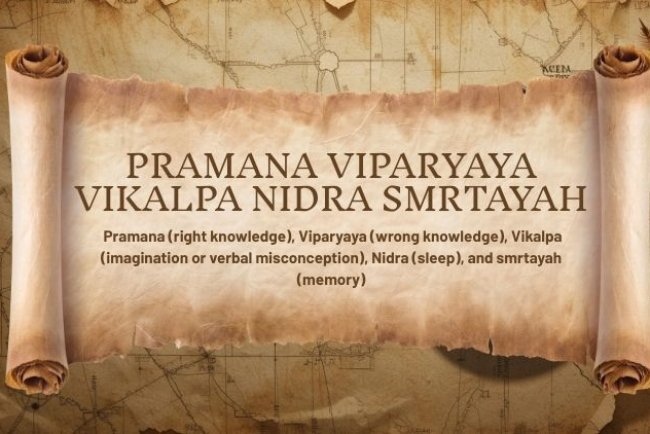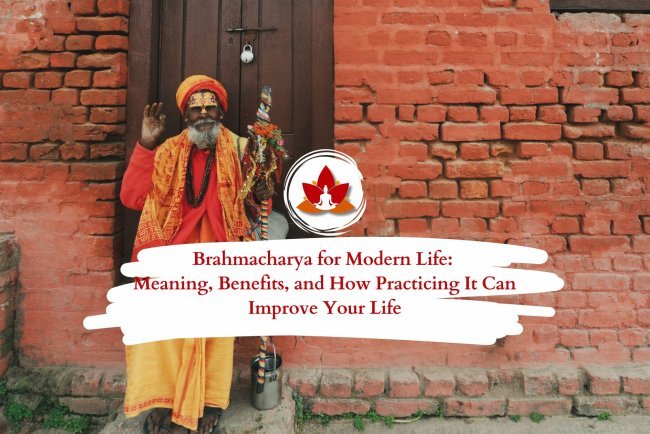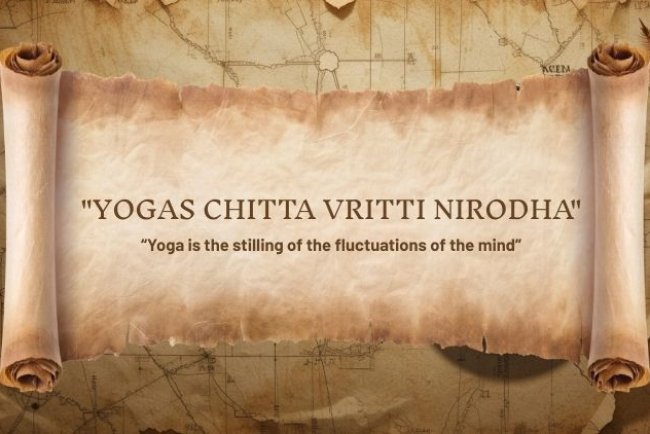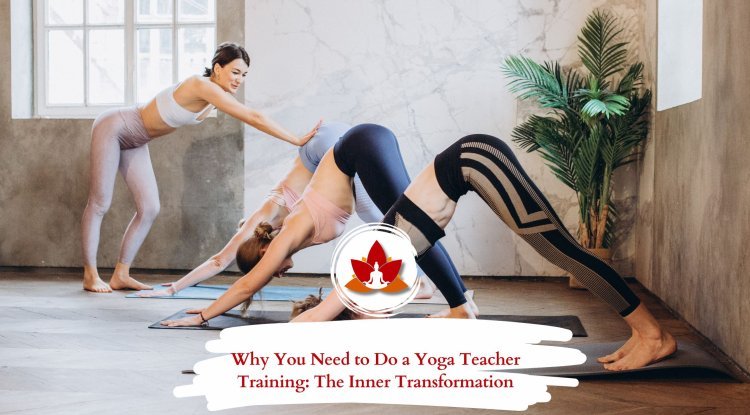Yoga Sutra 1.15 : Drsta Anusravika Visaya Vitrsnasya Vasikara Samjna Vairagyam

The moment we step into the depth of yoga philosophy, one term begins to resonate in our hearts: vairagya.
Often translated as “detachment” or “dispassion,” its meaning goes far beyond those words. Vairagya touches the very foundation of how we relate to the world, to our desires, and ultimately, to ourselves.
According to Sage Patañjali, vairāgya is one of the two essential pillars of yoga practice—paired with abhyāsa (steady, consistent practice). Without it, the path of yoga is incomplete, like trying to walk on one leg.
In this exploration of Yoga Sutra 1.15—Drsta anusravika visaya vitrsnasya vasikara samjna vairagyam we will dive into its true significance, its role in daily life, and how it guides us toward freedom, clarity, and inner stability.
What does Vairagya mean?
The Sanskrit word vairagya comes from vi (without) and rāga (passion, attachment, longing). At its core, it describes a state in which the grip of craving loosens, allowing us to live fully without being controlled by possessions, pleasures, or outcomes.
Importantly, vairāgya is not apathy, nor is it an escape from life. Instead, it is the capacity to savor life’s experiences without clinging to them or letting them dictate our peace of mind.
Imagine holding a flower gently in your palm. You admire its color, inhale its fragrance, and enjoy its presence—but when it withers, you let it go without sorrow. That gentle openness, free from attachment yet full of appreciation, is the essence of vairāgya.
Yoga Sutra 1.15 Translation
Sanskrit: दृष्टानुश्रविकविषयवितृष्णस्य वशीकारसंज्ञा वैराग्यम् ॥१५॥
Transliteration: Dṛṣṭānuśravika-viṣaya-vitṛṣṇasya vaśīkāra-saṁjñā vairāgyam (1.15)
Translation:
Vairāgya is the state of mastery that arises when one is free from craving for objects—whether directly experienced (dṛṣṭa) or only heard of through scripture and tradition (anuśravika).
Word-by-Word Meaning:
- drsta = seen, directly experienced
- anusravika = heard from scripture or tradition
- visaya = objects of the senses
- vitrsnasya = freedom from thirst or craving
- vasikara = mastery, control, self-mastery
- samjna = recognized as, defined as
vairagyam = dispassion, detachment, non-attachment
The Heart of Vairagya
When Patanjali speaks of vairāgya, he is not asking us to abandon the world. Instead, he is guiding us toward mastery over our desires. The sutra emphasizes vaśīkāra—self-mastery—the ability to remain steady even in the presence of tempting attractions. These may be obvious, like food, money, or fame, or more subtle, like promises of heavenly pleasures or mystical powers described in spiritual texts.
At its essence, vairagya is about freedom. It is not the freedom of rejection, but of choice. True vairāgya allows us to say “yes” to life wholeheartedly—without being bound or controlled by the outcomes of our choices.
The importance of Vairagya in yoga
Without vairāgya, the mind remains restless—pulled outward by endless desires. It gets caught in the constant loop of wanting: “I need this… I want that… What if I lose what I already have?” Even in meditation, these unresolved cravings disturb our stillness.
Vairāgya creates space. By quieting the noise of longing, it opens the door to inner peace and allows us to rest in the bliss of simply being. In that silence, the deeper truths of yoga are revealed:
- In Meditation: A detached mind observes thoughts as they rise and fall, without chasing or clinging to them.
- In Relationships: Vairāgya allows us to love fully—without trying to control or possess the other.
- In Daily Life: We can give our best effort without being crushed by anxiety over results.
In essence, vairāgya reshapes our perception. It transforms confusion into clarity, restlessness into peace, and attachment into freedom.
Vairāgya vs. Indifference
One of the most common misunderstandings is to mistake vairāgya for indifference. But the two are very different.
Indifference is apathy—a cold “I don’t care.”
Vairāgya, on the other hand, is alive, warm, and fully aware. It is about caring deeply, but without clinging to outcomes.
- Indifference closes the heart.
- Vairāgya opens the heart, yet frees it from attachment.
For example, a parent practicing vairāgya continues to love their child completely, but without the need to control every detail of the child’s life. The love remains whole, but the anxiety of possession falls away.
How We can apply Vairāgya in our Lives
Vairāgya is not reserved for monks or ascetics—it is meant for all of us, right in the midst of daily life.
- In Career: Work sincerely and give your best, but release the anxiety of success or failure.
- In Possessions: Enjoy what you have, yet remain calm if it is lost. Gratitude replaces fear of loss.
- In Relationships: Love deeply, but without binding. Support wholeheartedly, but without controlling.
- In Health: Care for your body, but without obsession over looks or appearances.
Practicing vairagya in this way makes life lighter, freer, and more joyful—allowing us to engage fully without being weighed down by attachment.
The Two Levels of Vairāgya
Commentators on Patañjali often describe two stages of vairagya:
-
Apara-vairāgya (Ordinary Detachment): The letting go of desires for worldly pleasures, wealth, recognition, or status.
-
Para-vairāgya (Supreme Detachment): The release of even the most subtle desires—such as the longing for spiritual powers, mystical experiences, or heavenly bliss.
The first stage is accessible to all of us in everyday life, while the second is rare and found mainly among advanced seekers. Yet both ultimately guide us toward the same goal—freedom and liberation of the spirit.
How to Cultivate Vairāgya
Detachment doesn’t happen overnight—it is a gradual practice, much like asana or meditation. Here are some practical ways to nurture it in daily life:
- Practice Awareness: Observe your cravings without judgment. Notice how they arise, linger, and naturally fade away.
- Simplify Your Life: Let go of unnecessary possessions and distractions that weigh you down.
- Mindful Consumption: Whether it’s food, media, or material goods, choose consciously rather than consuming compulsively.
- Shift Your Identity: Remind yourself that you are not defined by your roles, possessions, or achievements.
- Pair It with Abhyasa: Balance detachment with steady practice. Together, vairāgya and abhyāsa are like the two wings of a bird—both are essential to truly soar.
Vairagya and Freedom
At its heart, vairagya is about freedom—the freedom to be fully present, unshaken by the fear of loss or the hope of gain. When we are no longer enslaved by cravings, we can finally rest in the simple joy of being alive.
This is why Patanjali places vairāgya at the very core of yoga. It clears the path for stillness, sharpens clarity, and ultimately leads to liberation (kaivalya).
Conclusion
Yoga is not confined to asanas, postures, or even meditation techniques. It is, above all, a shift in how we live and how we relate to life itself. As Sutra 1.15 reminds us, vairāgya is not the renunciation of life, but the renunciation of bondage.
When practiced gently and consistently in daily life, vairagya allows us to love without clinging, to work without anxiety, and to live with a freedom untouched by external circumstances. It teaches us that peace is not something to be found “out there,” but something that has always been within us—waiting in the stillness of a detached heart.
What's Your Reaction?


























